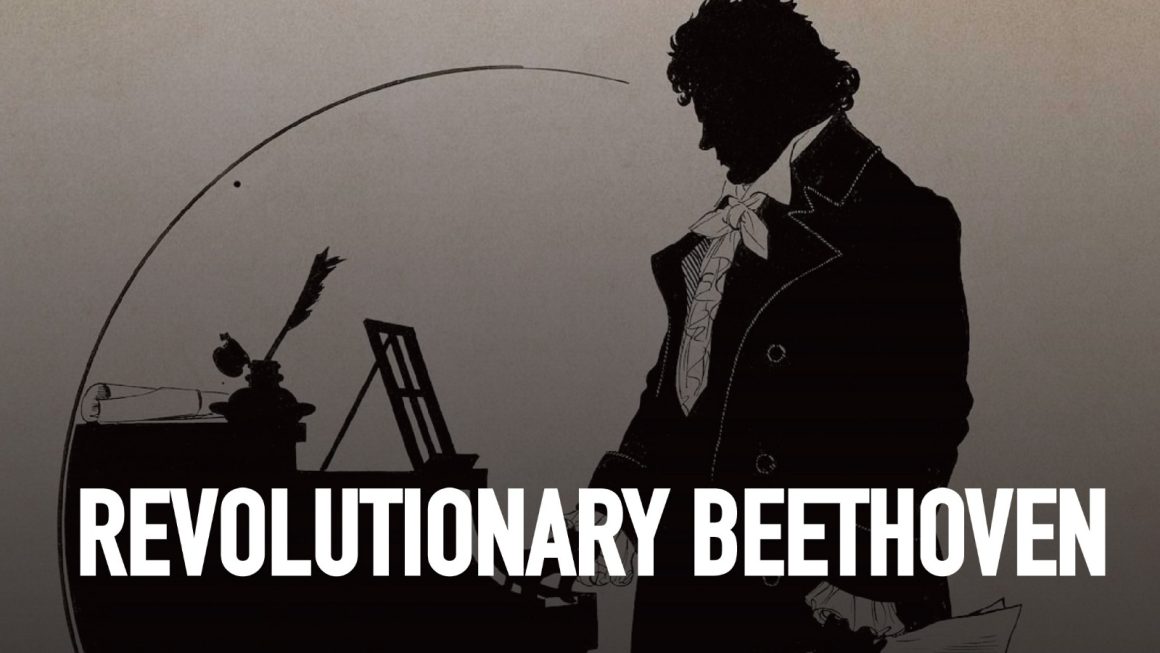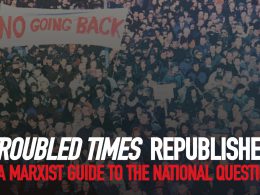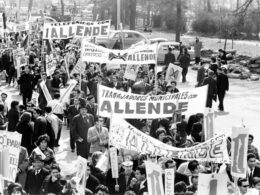By Bill Hopwood- Socialist Alternative — our sister organisation in Canada
This December 250 years ago Ludwig Beethoven was born. Beethoven’s musical beauty and genius is best understood in the context of the revolutionary changes of his time — in society and art.
A towering figure of music, Beethoven was born on December 16, 1770. He grew to be a genius of the European tradition of classical music. His life was a time of turmoil and revolution and at a crossroads of an artist’s relation with society. Beethoven’s musical beauty and genius is best understood in the context of the revolutionary changes of his time — in society and art.
Art and humanity
Artistry and aesthetics are qualities of being human, and even part of the natural world. While the diversity and forms of life are driven by evolution, beauty abounds in nature. Mathematicians say given a choice between two proofs of a theory, choose the more beautiful.
Almost from the first human artefacts a sense of aesthetics is evident, alongside their utility. Everyday tools have a beauty, often with some decoration. Bill Reid, a famed Haida artist, wrote that “one basic quality unites all the works of mankind that speak to us in human, recognizable voices across the barrier of time, culture and space. The simple quality of being well made.”
Humans wove artistry into life including tools and everyday objects such as bowls, needles and clothing. These objects were not bought to be soon discarded, but were made to last. Of course, part of the artistry is the beauty of design to do the required job well. Objects that are handled need to fit the hand and clothes need to fit the body. Purpose drove aesthetics. Observe the genius and simple stunning beauty of an igloo — building a weather-proof, warm dwelling out of the most plentiful material at hand, packed snow!
Most people had artistry and made things well. Some would be more skilled than others in this work — weaving baskets, shaping a knife from obsidian, sewing clothes or carving a needle from bone. But these skilled workers were not separate from their society.
However, as class society emerged, “art” became something separate from everyday life. A minority of people became rich and powerful, both religious and secular although often these roles were combined. They were a new social phenomenon — a ruling class. They used objects to show the wealth and power of the rich and their god(s), to the glory of the rulers. Features of these objects were aesthetics and they were well made. The wealth of the rulers paid for glorious works such as buildings, statues and large paintings. In spite of their original purpose, a Marxist can appreciate the artistry, the well-made quality.
However, the ruling class didn’t make these works of art, they didn’t work so could not make works of art. They employed others to make the art. A section of society became artists, a group of workers who gained their living from making “art” for other people.
The rest of artistic endeavours outside of high art became classed as handicrafts, in particular work done by women such textiles and basketry, or folk art. Among the majority of humanity, a vibrant culture including storytelling, dance and drama continued.
Changing society
For many centuries ownership of land was the basis of the wealth of the aristocracy and church. In Europe, a new social force grew during the Middle Ages. They were city dwellers, who had wealth, not from owning land, but through trade and business. They were merchants, traders, and owners of establishments where groups of workers were gathered together to make things they did not own. In most Germanic languages some variant of burg (original meaning castle) means town or city, such as burgh, borough, borg, bourg, etc. The citizens of a city, excluding the servants and poor, became called burghers, bürgers, burgers or, in French, bourgeoisie.
This class increasingly challenged the power of the courts and the church. As they became richer, they argued they should have more say. In England in the 1600s the cities were represented in the House of Commons while the church and aristocracy ruled the House of Lords. The House of Lords and the monarch made the major decisions while the commoners, in particular the richer commoners, the bourgeoisie, paid the taxes.
By the time of the English Revolution, 1642 — 1651, the Commons had more wealth than the Lords but far less political power. The revolution was about the Commons gaining more power compared to the aristocracy and church. The burgers of the Netherlands, after a long and bloody war, won the independence from the Spanish Empire in 1648.
Change was in the air of Western Europe. This change was more than changing the rulers and national boundaries. There were profound changes: in religion, the Reformation; science, in many ways its rebirth; technology, the roots of the industrial revolution; and culture.
It was also the time of global conquest as the merchants of Europe sought new sources of goods and new markets. New foods arrived in Europe including the potato, corn, tomato, chocolate and green beans. The ruling class conquered much of Africa, the Americas and Asia with ensuing horror and misery for most of the inhabitants of these continents and colossal wealth for the merchants and ruling class.
These broad changes in society impacted art — as was inevitable as art is rooted in society. New techniques emerged, the most important being the printing press. This allowed the accurate and rapid reproduction of text and prints, with huge impacts on society. Oil-based paints replaced tempera in the 16th and 17th centuries, which allowed richer colours and the appearance of light. Gas lighting — brighter, cleaner and easier to control than candles — changed theatres. New musical instruments — such as the piano, guitar, French horn and clarinet — were invented or evolved from older ones.
Art was no longer primarily about, or glorifying of, rulers and religion. Bach’s music was to the glory of god. New ideas abounded and ordinary people appear in art. The novel emerged, focusing on lives of people. Painters, such as the Brueguls (father and two sons), portrayed everyday life.
A new urban affluent class changed the way artists earned their living. They no longer had to rely on rich patrons but could sell their art directly to the public. Areas where this first impacted included the theatre and publishing. Books, pamphlets, sheet music and images could be reproduced relatively cheaply and sold in large numbers. Theatres, with paying audiences — presented plays, opera (developed first in Italy at the start of 1600s) and other performances — became common in cities.
Beethoven’s life and times
Ludwig van Beethoven was born in Bonn, beside the Rhine River, to a musical family. The Rhine had long been a route for travel and trade connecting a large part of the interior of western Europe, and into eastern Europe via the Danube, to the mighty port of Amsterdam, and from there the world. The changes flowing across Europe flowed along the Rhine and into Bonn. The Wupper river valley, 75 kilometres to the north, was a birthplace of the industrial revolution.
Compared to most of the rest of the lands that became Germany, the Rhineland was more progressive and cultured, less dependent on agriculture based on peasants, and more urban. Change and revolution was in the air of the society and times Beethoven was born into. The old feudal order was in decay and the rising bourgeoisie was demanding more rights and powers. Philosophers talked of human rights rather than subservience to the lords, temporal and spiritual.
In France, to the west, feudalism seemed to reach a full flowering under the reign of Louis XIV, known as the Sun King, from 1643 to 1715. But beneath the splendour of the elites, the old regime was rotting within. In 1789 the French Revolution erupted. Although there had been earlier bourgeois revolutions in the Netherlands, England and the United States, the sweep and power of the French revolution had far greater impact across Europe.
Progressives, urban bourgeoisie, and young people were inspired by the Revolution and its bold slogan of “Liberté, égalité, fraternité.” Beethoven was one such person, eighteen years old when the Bastille was stormed. Wordsworth, also born in 1770, wrote of the Revolution:
“Bliss was it in that dawn to be alive,
But to be young was very heaven!
O times . . . When Reason seemed the most to assert her rights.”
In contrast, the old regimes of Europe and the Catholic Church looked on in horror as their friends and relatives lost their land and titles and a few, their lives.
Beethoven’s musical education, at times harshly delivered, began at a young age. In 1792, he moved from Bonn to Vienna, a musical centre, to further his education. By 1795 he was composing and performing and gaining an income from the sale of tickets and published music. He was a noted pianist, on an instrument that had only existed for 100 years and which was rapidly developed during his lifetime to be louder, with a wider range of octaves. His later compositions, with large loud orchestras, were only possible due to technical and social change.
Beethoven did receive income from rich patrons but most of his income came from performances and published music. This was a historic shift. Mozart, only 14 years older than Beethoven, received most of his income from annuities and employment by aristocrats and the church, although he, too, earned some money from performances in his later life. Beethoven had a financial independence that gave him a musical independence.
By the early 1800s, Beethoven was reaching maturity but also started going deaf, with his hearing declining over the rest of his life. He had periods of despair both from his deafness and personal setbacks. He wrote about considering suicide, but rejected it, writing “it was only Art it was that withheld me, it seemed impossible to leave the world until I had produced all that I felt called upon me to produce.”
In 1804 he composed the Third Symphony, which marked a departure from previous music. Originally, he intended to dedicate it to “Bonaparte,” reflecting Beethoven’s support for the French Revolution. After Napoleon declared himself Emperor of France, Beethoven scratched Napoleon’s name from the title page, and the symphony was published in 1806, entitled “Eroica” and subtitled “to celebrate the memory of a great man.”
France was defeated in 1814, which ushered in a period of reaction in Europe as the old order (ancien regime) tried to stamp out revolutionary ideas and movements. Vienna was a centre of reaction. The decade after the defeat of France were grim years for Beethoven, politically and socially, due to deafness and growing isolation, family conflicts and poor health. He never married or had children.
His great works are not as easy to listen to, compared with those of his predecessors, such as Haydn or Mozart, who he learned from, then overcame. Mozart’s music has contrast, a to and fro, which reflected the world around him. Contrast was in the air of society at the end of the 18th century, as the feudal order of everyone knowing their place was breaking down. Mozart resolves the contrast into harmony, much like the better-off hoped would happen in society.
The contrast mounted into tension and conflict and erupted in 1789 in Paris into revolution. Beethoven took the structure of the symphony and transformed and transcended the old feel of it. His music, like society, is full of tensions, clashes and conflicts. His great works reach a conclusion, a crescendo, but it may not be harmony, but tension.
His music and his views were revolutionary. To one of his patrons, prince Lichnowsky, he wrote, “Prince, what you are, you are by accident of birth; what I am, I am of myself.” Franz II, Emperor of Austria, disliked Beethoven’s music as there was “something revolutionary in the music.”
Ninth Symphony
Beethoven’s Ninth symphony is considered among the greatest pieces of music ever composed. It was his last major work and, in many ways, sums his life and times in majestic music. First performed in 1824, it was years in the making. These years had been some of the hardest, with depression and poor health.
The feeling is of struggle, of hope thrown back only to return, time and again. This reflects his life, his hopes, sorrows, joys and disappointments in his art, in love, and his deafness. But ever again he arose revived. It also feels like a re-affirmation of the hope of his youth in humanity, the hope of the French Revolution.
There is struggle, tension, hope, seeming success, then setback, bleak times and then the hope returns, questing for a better world. It could be the score to a revolution. There are times full of hope and joy, periods of quiet peace and other times of discord, despair, retreat and reaction. But through it all, hope continues: sometimes a sparkling brook, at other points, a slow weak stream and still other times, a powerful river. But after three movements, nothing is resolved. Only with the human voices is the triumph. Hope becomes joy, having overcome all adversity and humans have stormed the gates of heaven. The finale is overwhelming, brimming with hope, joy and freedom.
In an innovation, the final movement includes the human voice singing, both chorus and solo, Schiller’s poem Ode to Joy. Schiller was a German writer influenced by the ideas of the rising bourgeoisie; he wrote against absolutism of rulers and in favour of freedom. Ode to Joy could be called Ode to Humanity or Ode to Freedom, with the lines “All people will be brothers, be embraced you millions!” It is widely understood that originally Schiller wrote the poem as an ode to Freedom. In German Joy is Freude while Freedom is Freiheit.
The Ninth has been used by many, some reactionary, but mostly by the workers’ movement and people in struggle. The European Union, an organisation with little do with solidarity, used it. In contrast, ordinary people performed and sang it from windows and balconies during the first part of COVID lockdown in several European countries.
The great US Black singer (and Communist sympathizer), Paul Robeson, wrote these words to capture what the symphony expresses: “None shall push aside another, None shall let another fall. March beside me, Oh my Brother, All for one and one for all.” It is true Schiller’s poem can be interpreted as praise of god, but in the 18th century writers were still searching for a vocabulary free of god(s) and religious terms. Beethoven didn’t go to church and probably, like many of his time, was more of a deist than a Catholic, believing in some vague spirit. No words can do justice to the music — listen to it!
Beethoven knew that life or change — a revolution — is not an event but a vast process of struggle. He would not see his hopes for humanity realized but he used his art to help those hopes be realized. Revolutionaries want to overthrow repressive regimes of society and art; Beethoven was a revolutionary. His breadth of imagination, strength of determination and abundance of hope that his work would inspire others enabled him to write brilliant music that he would never hear. He had the character of a revolutionary — imagination, determination and hope.
After Beethoven
Beethoven was a great disrupter in music, which would never be the same.
The area of Beethoven’s birth, the Rhine valley, was a centre of revolutionary attitudes. Marx, born in 1818 in Trier, and Engels, born in 1820 in the Wupper valley, breathed that air. Marx wrote for the Rheinische Zeitung, based in Cologne from 1842 until it was banned in 1843. On the eve of the German revolution of 1848, he returned to Cologne, launching a daily newspaper, the Neue Rheinische Zeitungit, until it too was suppressed, and he was exiled.
The German Revolution of 1848–49 failed as the liberal bourgeoisie feared the workers more than they wanted to end the yoke of feudal rule. Engels fought in the battles of the revolution along the Rhine. He was one of the last fighters to flee, reaching Switzerland on July 25, 1849. Later, in 1871, Germany was unified by Prussia and became a major capitalist and industrial power.
In Beethoven’s time, and for a time after, the capitalists were a newly arrived revolutionary class: confident, dynamic and bold. This rising bourgeoisie increasingly became owners of industry, and in those workplaces a new class grew in strength. The working class, or proletariat, made objects for wages but the owners of the workplaces, and increasingly factories, owned the products and controlled the working conditions. Workers were alienated from their work and what they made. The capitalists grew rich by selling the products of the work of others; the objects were commodities.
Today, the capitalist class is decrepit and degenerate, dragging humanity into disaster after disaster, unable even to take the simple actions of test, trace and provide PPE to protect people in a global pandemic. But now another class has grown to billions strong: the working class. Like the capitalists in the early days, the working class has yet to realize its power and potential to change the world. Unlike the capitalist class, the working class is the majority of humanity.
The bourgeois revolution, at the start, inspired Beethoven and many others. The proletarian revolution will be wider and deeper and inspire many millions. The Russian Revolution showed a glimpse of the explosion of culture after a revolution. The socialist revolution will blaze across the earth, in new heights of culture where things are well made and art is re-united with life.












